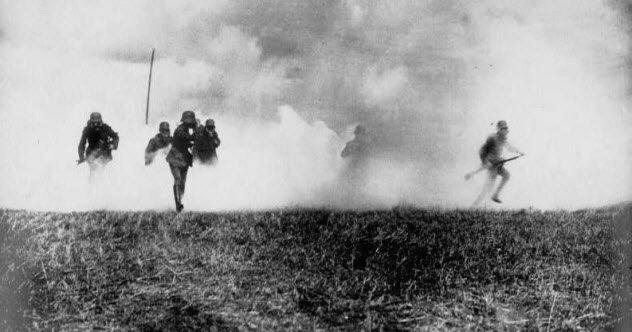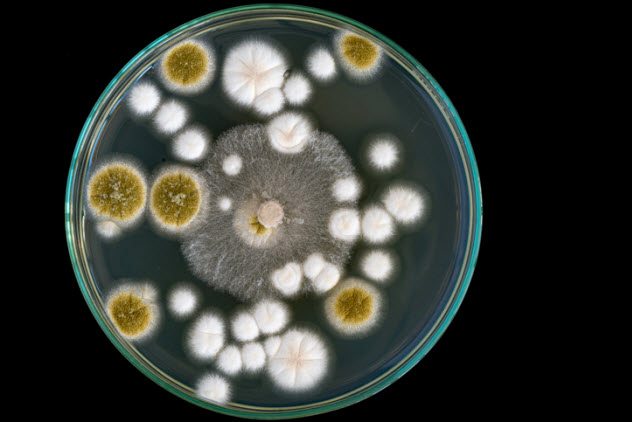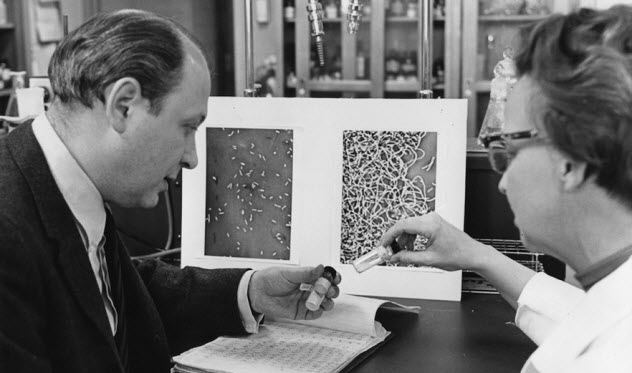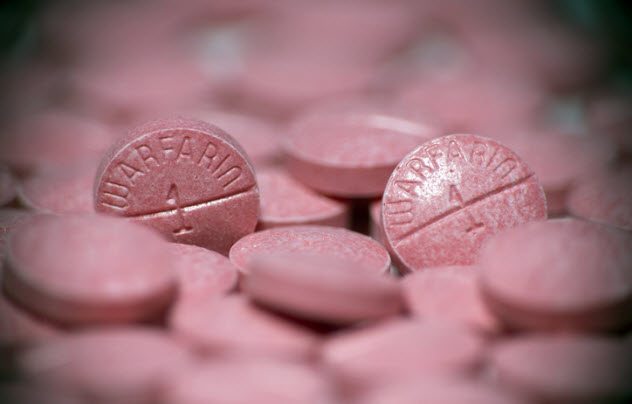 Our World
Our World  Our World
Our World  Movies and TV
Movies and TV 10 Times Twin Movies Competed with Each Other
 The Arts
The Arts 10 Masterpieces Plucked from the Artist’s Subconscious
 Crime
Crime 10 Fascinating Facts about Rikers Island
 Pop Culture
Pop Culture 10 Things You Might Not Know about Dracula
 Weird Stuff
Weird Stuff 10 Everyday Activities That Were Once Considered Illegal
 History
History Ten of History’s Hidden Secrets: Stories 99% Don’t Know About
 Movies and TV
Movies and TV 10 Actors Who Infamously Stormed Off Set While Filming
 Food
Food 10 Foods That Have Alleged Occult Powers
 Sport
Sport 10 Lesser-Known Multi-Sport Alternatives to the Olympics
 Our World
Our World Planet Earth’s 10 Most Hardcore Natural Creations
 Movies and TV
Movies and TV 10 Times Twin Movies Competed with Each Other
 The Arts
The Arts 10 Masterpieces Plucked from the Artist’s Subconscious
Who's Behind Listverse?

Jamie Frater
Head Editor
Jamie founded Listverse due to an insatiable desire to share fascinating, obscure, and bizarre facts. He has been a guest speaker on numerous national radio and television stations and is a five time published author.
More About Us Crime
Crime 10 Fascinating Facts about Rikers Island
 Pop Culture
Pop Culture 10 Things You Might Not Know about Dracula
 Weird Stuff
Weird Stuff 10 Everyday Activities That Were Once Considered Illegal
 History
History Ten of History’s Hidden Secrets: Stories 99% Don’t Know About
 Movies and TV
Movies and TV 10 Actors Who Infamously Stormed Off Set While Filming
 Food
Food 10 Foods That Have Alleged Occult Powers
 Sport
Sport 10 Lesser-Known Multi-Sport Alternatives to the Olympics
Top 10 Crazy Pharmaceutical Drug Origin Stories
The estimated value of the US pharmaceutical industry was $446 billion in 2016. In fact, the research and development spending per employee is unparalleled by any other industry. Despite this, the discovery of revolutionary drugs and treatments is sometimes a case of noticing something unexpected, looking for something else, or just pure luck.
10 Chlorambucil

Chlorambucil is an antileukemia drug first approved by the FDA in 1957. Leukemia is cancer of the blood cells and is one of the leading cancers in individuals under age 15. The origins of this drug go all the way back to the use of mustard gas on World War I battlefields.[1]
Many years after the war and under the threat of World War II, researchers at Yale were looking into treatments for mustard gas poisoning when they noticed that soldiers exposed to the gas had unusually low white blood cell counts.
This led to the discovery that nitrogen mustard–based compounds could be used in the treatment of leukemia to kill mutated and cancerous white blood cells and prevent further tumor division. More research led to the development of chlorambucil, which is still used to treat these types of cancers today.
9 Viagra

There is no doubt that Viagra is a highly used and appreciated pharmaceutical discovery worldwide. Its popularity stems from its widespread use in pop culture, especially in Hollywood.
However, the story of its discovery is a little more sedate. It started in Merthyr Tydfil, a small Welsh town in the UK. Scientists testing a new angina-prevention drug received reports of an unexpected effect from the volunteers.[2]
Male participants were experiencing more frequent erections. Further research indicated that it was indeed the angina medication causing this effect, and thus, the “little blue pill” was born.
It was marketed as the first oral treatment for erectile dysfunction in 1998. Now, 20 years later, it has become one of the most prescribed drugs in the world.
8 Botox

Almost everyone has heard of Botox and its infamous face-freezing effect, leaving countless “celebrities” devoid of facial emotion. But fewer are aware of the drug’s surprising origins. Botox is actually a neurotoxin that is made from a purified form of the botulinum toxin that causes botulism.
It was first used as a drug to prevent muscle spasms within the body, specifically for people suffering from eyelid or vocal cord spasms. However, its usage around the eyes had some unexpected effects. The drug began to diminish wrinkles around the brow area of the face, which led to its use in cosmetic surgery to reduce facial wrinkles and to smooth skin.
The rapid evolution of this treatment has led to Botox cosmetic surgery becoming one of the most popular medical treatments, with over seven million procedures in the US alone in 2016.[3]
7 Smallpox Vaccination

In the late 18th century, Edward Jenner made remarkable contributions to the development of the smallpox vaccine. Smallpox was one of the most feared diseases due to its high mortality rate and the extensive facial scarring inflicted on those who survived.
Prior to Jenner, the only preventive measure was variolation (inoculation) using pustule material from someone who already had the disease. Variolation led to a less severe case but could still result in death.[4]
However, in his small-town practice in rural England, Jenner noticed that milkmaids who caught the less serious cowpox would not catch smallpox. This idea of infection with a less harmful virus led to the development of the vaccination. (Vacca is Latin for “cow.”)
The importance of developing the smallpox vaccine cannot be understated. In 1980, the World Health Organization declared this once-feared disease officially eradicated, making it the first and only disease to achieve this status.
6 Lithium

The treatment of bipolar disorder (formerly known as manic depression) has varied greatly throughout history. Sadly, until the late 20th century, patients were often confined to asylums. However, in 1948, Australian psychiatrist Dr. John Cade devised a revolutionary treatment using lithium salts.
This discovery came from his testing of the incorrect historical belief that a link existed between urea and mania. Cade took a somewhat unorthodox approach by collecting urine from patients and storing it in his own kitchen fridge to inject into live guinea pigs.
Over time, he began to inject uric acid directly into the guinea pigs, using lithium urate as it was so highly soluble. Lithium salt caused the animals to become relaxed, so Cade later tried it on himself with similar results.[5] His work paved the way for the current leading treatment of bipolar disorder.
5 Penicillin

Although many people have heard of the chance discovery of penicillin by Alexander Fleming in 1928, very few know the story of Ernst Chain and Howard Florey, the men who developed penicillin into a drug. All three men shared the Nobel Prize in Medicine in 1945 for their work on penicillin.
While studying antibacterial substances at Oxford University in the 1930s, Chain, Florey, and their team began researching Fleming’s work on penicillin and devised a plan to mass-produce the penicillin mold to treat infections.
Their culturing methods included the use of old dairy equipment and even Marmite as a growth medium. One early favored method involved the use of cantaloupes, which was successful enough to begin clinical trials.
The two men’s efforts did not go unnoticed by the US armed forces. During World War II, the military realized penicillin’s potential to treat battle wounds for infections and began mass-production of the drug for the D-day landings. Penicillin went on to save countless lives during the war and beyond.[6]
4 LSD
 Lysergic acid diethylamide (LSD) is a Schedule I psychoactive substance that can cause intense hallucinogenic experiences for users. Ordinarily, it would not be considered a pharmaceutical drug. However, it has recently shown promise in the treatment of post-traumatic stress disorder.
Lysergic acid diethylamide (LSD) is a Schedule I psychoactive substance that can cause intense hallucinogenic experiences for users. Ordinarily, it would not be considered a pharmaceutical drug. However, it has recently shown promise in the treatment of post-traumatic stress disorder.
LSD was first synthesized in 1938 by Swiss chemist Albert Hofmann in the search for a blood circulation stimulant. However, this proved fruitless, so it was set aside for five years.
Upon resynthesizing the drug in 1943, Hofmann accidentally ingested a small amount from his fingertips, leading to an experience he described as “an uninterrupted stream of fantastic pictures, extraordinary shapes with intense, kaleidoscopic play of colors.”[7]
Three days later on April 19, Hofmann purposely ingested a larger dose of the drug and experienced what is known by LSD fans as Bicycle Day (named after the mode of transport that Hofmann used to return home during his “trip”). With this, LSD was born and became popular as a symbol of the “flower power” movement during the 1960s. The drug is still used today.
3 Disulfiram

More commonly marketed as Antabuse, disulfiram is used to reduce alcohol addiction. The drug reacts with the alcohol consumed to cause nausea and an increased heart rate. This is meant to be a deterrent for drinking.[8]
Two Danish medical researchers, Jens Hald and Erik Jacobsen, originally tested this drug as an antiparasitic. Each decided to try small samples to establish the side effects. Later, at an after-work cocktail party, this turned out to be a big mistake.
After the men consumed small amounts of alcohol, both rapidly became violently ill. This led them to conclude that the two events were connected and that their antiparasitic might have another use.
Interestingly, upon further research into this drug, it was noticed that workers in the rubber industry had already known about this connection for some time. The same type of reaction to alcohol was observed in those who used similar chemicals in the production of rubber, but the two were not yet linked.
2 Cisplatin

Cisplatin is used in the treatment of testicular cancers. In fact, it is estimated to cure up to 90 percent of cases of this type of cancer.
The discovery of the drug’s anticancer properties by US chemist Barnett Rosenberg in the 1960s occurred mainly by chance. Rosenberg was testing a hypothesis based on the effect of strong electrical fields on E. coli when he noticed that it was able to prevent division of the bacteria’s cells.[9]
Rosenberg discovered that the use of platinum electrodes caused this effect, not the electrical current. He had actually synthesized a chemical known as “Peyrone’s chloride” that was first isolated in the 1840s. But its use in the treatment of cancer had not yet been realized.
Since this initial development in the 1960s, cisplatin has become one of the leading anticancer drugs worldwide.
1 Warfarin
 Warfarin began with the drama of dead cattle, dead rodents, and a failed suicide before becoming the most popular anticlotting drug in the world. It is used by as many as 1 percent of adults in the UK.
Warfarin began with the drama of dead cattle, dead rodents, and a failed suicide before becoming the most popular anticlotting drug in the world. It is used by as many as 1 percent of adults in the UK.
During the 1920s, the northern US and Canada experienced an epidemic of dying cattle that were bleeding profusely. An investigation determined that the problem was caused by the cattle eating moldy silage made from sweet clover, and so the case was closed at that time.
Then, in the 1940s, Karl Link and his student Harold Campbell in Wisconsin isolated the compound responsible for the anticoagulant properties in sweet clover. This was developed into warfarin, which was licensed as a rat poison in 1948. It caused massive internal hemorrhaging in rats unfortunate enough to consume it.[10]
Now, the most popular use of warfarin is in the prevention and treatment of diseases like stroke that are caused by blood clots. The drug was not licensed for use in humans until 1954 after a US military recruit’s failed suicide attempt showed that warfarin could be used in a nonfatal manner. Interestingly, one of the first recipients was then-President Dwight D. Eisenhower.
Josh Sandy is an aspiring pharmacology student from the UK with a penchant for weird stories and a depressing obsession with politics.
Read more bizarre stories about drugs on 10 Crazy Drugs You Don’t Know (And Don’t Want To) and 10 Crazy Myths About Illegal Drugs.








